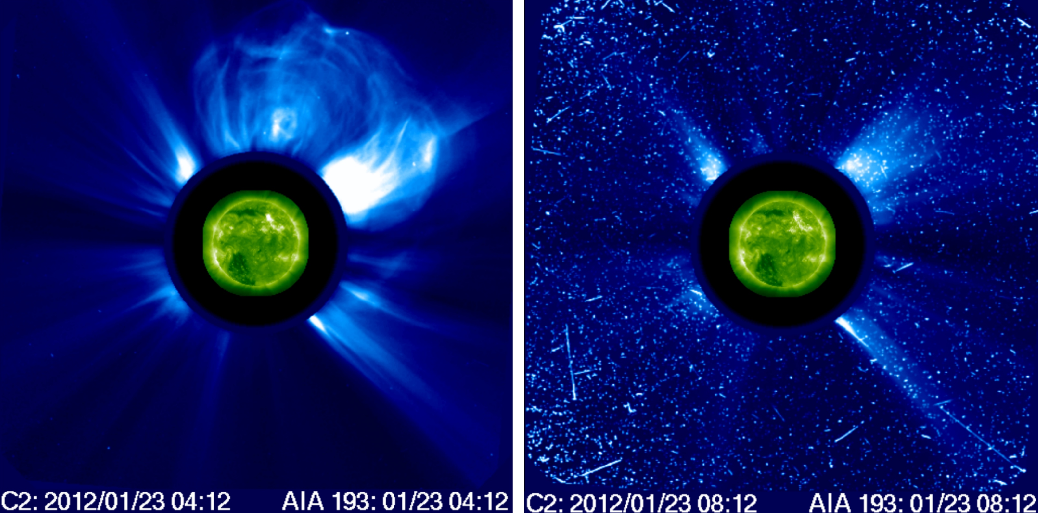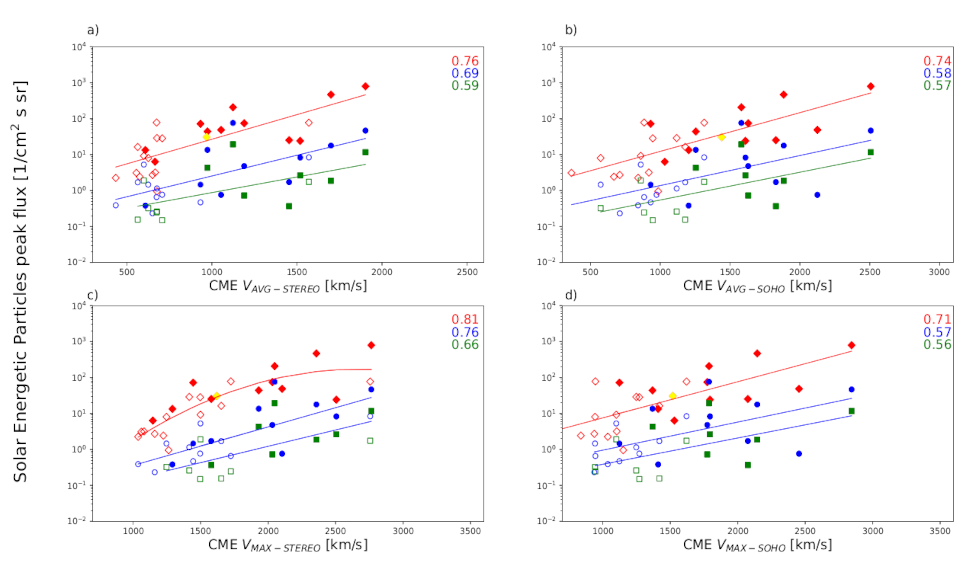Astronomy Object of the Month: 2020, August
< previous Archive next >
Non-interacting coronal mass ejections and solar energetic particles near the quadrature configuration of Solar TErrestrial RElations Observatory
Space weather is mainly controlled by the
strong magnetic storms and particle storms which are caused by the enhanced
fluxes of protons and ions. These accelerated plasmas are known as solar energetic particles (SEPs). The generation of SEP is mainly due to two
phenomenon, impulsive SEP events caused by magnetic reconnection manifested as solar flares, and gradual SEP events accelerated by strong shocks
associated with coronal mass ejections (CMEs). In this paper we
have shown that our method of employing so-called instantaneous speed (maximum speed and the CME speed and Mach number at SEP peak flux) offers
better correlation than the average speed. In addition, we observe poor correlation between fluxes of SEPs and Flares, which
support the hypothesis that energetic particles observed in the considered energy range are predominantly accelerated by CME shock.

Coronal Mass Ejections (CMEs) are intensive outbursts of plasma and magnetic field that play a key role in causing strong geomagnetic storms on the Earth. The large, gradual, and long-lived SEP events are of particular interest as the arrival of the associated interplanetary CME and shock and the enhanced SEP fluxes can cause severe damages to satellites in space and technology on the ground. SEP intensities and CME speeds are well correlated. The CME-driven shock scattersthe ions back and forth by the resonant Alfven waves amplified by the accelerated protons themselves as they stream away.
The scientific literature provides several results of good correlation studies between CME speed and the peak flux of the associated SEPs. It is worth to note that these considerations were based on average velocities of CMEs. In this paper, we continue to determine these correlations by employing our new approach of using the instantaneous speeds of CMEs of non-interacting halo CMEs near the quadrature configuration of Solar TErrestrial RElations Observatory (STEREO). The data from SOlar and Heliospheric Observatory (SOHO)/Large Angle and Spectrometric Coronagraphs (LASCO) and STEREO/Sun Earth Connection Coronal and Heliospheric Investigation (SECCHI) were employed to determine the kinematics of the CMEs. The SEP fluxes at three energy bands, > 10 MeV, > 50 MeV and > 100 MeV, from The Geostationary Operational Environmental Satellite (GOES-13) Energetic Particle Sensor (EPS) instrument, part of the Space Environment Monitor (SEM), was used to study SEP intensities. In addition, we discuss the relation of the X-ray peak flux of solar flares using GOES-15 data associated with the two phenomena.
From figure 2 we observe that CME velocities are well correlated with intensities of energetic proton for the three energy channels. The good correlation obtained for fluxes of protons in the > 10 MeV energy channel support the hypothesis that the protons are predominantly accelerated by shock waves generated by fast CMEs propagating in the interplanetary space. The > 50 and > 100 MeV energetic particles are also mostly accelerated by the same shock waves but a partial contribution by the associated flares can be also involved in their acceleration. CMEs originated close to the disk center (longitude < 35◦) have comparatively low velocities. For events originating in the longitude range between 35◦ and 65◦, we observe significant increase for the all considered velocities.
The simple conclusion of the paper is if the maximum speed and the CME speed and Mach number at SEP peak flux is determined (which occurs within 10 solar radius), the maximum flux of the associated SEP event can be easily determined using our empirical model. The disk and west limb events can produce the most powerful SEP events with fluxes ≈100 pfu in the 10 MeV energy channel as they are magnetically well connected to the Earth.
Solar flares and SEPs show poor correlation, further supporting the hypothesis of choosing the CME-driven shock as a better indicator of SEP acceleration.

Original publication: Ravishankar, A., & Michałek, G., Non-interacting coronal mass ejections and solar energetic particles near the quadrature configuration of Solar TErrestrial RElations Observatory , A&A, 638, A42, June 2020.
The research was conducted at the Department of High Energy Astrophysics of the Jagiellonian University’s Astronomical Observatory (OA UJ). The work was supported by the Polish National Science Centre through the grant UMO-2017/25/B/ST9/00536 and DSC grant N17/MNS/000038.
|
Anitha Ravishankar Astronomical Observatory Jagiellonian University A.Ravishankar [at] oa.uj.edu.pl |


